Edie Melson's Blog, page 98
February 17, 2023
The Life-Changing Power of Love-Imbued Writing
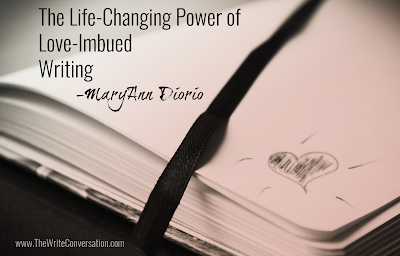
by MaryAnn Diorio, PhD, MFA @DrMaryAnnDiorio
Of all weapons against hardship, the most powerful is love. And love can also be our greatest weapon in the many hardships we face as writers.
How?
We writers who are Christ-followers fully understand the unique challenges we face as we seek to create works of art that please our Lord and bless our readers. We often struggle to overcome these challenges by sheer determination, stressful schedules, or physically unhealthful habits.
Yet, there is a weapon that will help us overcome every challenge every time. That weapon is love.
Let’s explore how love can help us in the following situations:
In the face of rejection . . .
When our writing is rejected for whatever reason, do we complain, retaliate, or sulk in self-pity? If so, we are not acting from a place of love but from a place of self. And self is the opposite of love.
In the face of discouragement . . .
When we face discouragement, do we give up? If so, we are not acting from a place of love but from a place of defeat. And defeat is the opposite of love.
In the face of trials . . .
When we face trials, do we murmur and complain? If so, we are not acting from a place of love but from a place of bitterness. And bitterness is the opposite of love.
In the face of fear . . .
When we face fear, do we run and hide? If so, we are not acting from a place of love but from a place of cowardice. And cowardice is the opposite of love.
In the face of success . . .
When we face success, do we boast and gloat? If so, we are not acting from a place of love but from a place of pride. And pride is the opposite of love.
In this month of February, traditionally dedicated to love, let us imbue our writing with the love of God. As Holy Scripture instructs us in Colossians 3: 23, “Whatever you do, work at it with all your heart, as working for the Lord, not for human masters.” The self can be a human master. We must guard against serving the self.
Writing is an act of love. Not only toward God but toward our readers. As writers, we will face rejection, discouragement, trials, fear, and, yes, even success. But when we do, let us always respond in love.
When we imbue our writing with love, we are imitating Christ. We are laying down our lives for our readers through the many sacrifices we make in order to write for them.
In 1 Corinthians 14: 1, the Word exhorts us to “make love our greatest aim.” Let us purpose to make love our greatest aim this year, not only in our writing but also in our life.
TWEETABLEThe Life-Changing Power of Love-Imbued Writing from author @DrMaryAnnDiorio on @EdieMelson (Click to Tweet)
 MaryAnn Diorio writes women's fiction from a quaint Victorian town in southern New Jersey where the neighbors still stop to chat while walking their dogs, the houses still sport wide, wrap-around porches, and the charming downtown still finds kids licking lollipops and old married couples holding hands.
MaryAnn Diorio writes women's fiction from a quaint Victorian town in southern New Jersey where the neighbors still stop to chat while walking their dogs, the houses still sport wide, wrap-around porches, and the charming downtown still finds kids licking lollipops and old married couples holding hands.A Jersey girl at heart, MaryAnn is a big fan of Jersey diners, Jersey tomatoes, and the Jersey shore. You can learn more about her at maryanndiorio.com.
Published on February 17, 2023 22:00
February 16, 2023
Avoid These Three Common Errors to Make Your Writing Sing
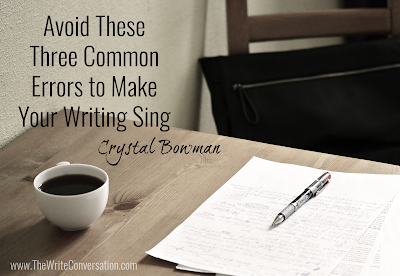
by Crystal Bowman
As professional writers, it’s important to pay attention to those easy-to-make mistakes and learn how to get them right. Is it important in light of eternity? Of course not! But if we want to do our best at what God has called us to do, then let’s keep learning and striving for excellence.
Here are three common mistakes that can make editors (and readers) cringe:
1. Using I when it should be me.
This could quite possibly be the most common grammatical error on the planet! The confusion starts in elementary school when Billy says to his teacher, “Can Jimmy and me sit together?” The teacher corrects Billy and says, “Jimmy and I.” From then on, Billy is sure that using I rather than me is always correct. But it’s not. When Billy and Jimmy become the object rather than the subject, it changes from “Jimmy and I” to “Jimmy and me.” For example: Please pass the ball to Jimmy and me.
The compound object is what makes it confusing. So here’s a simple trick—drop the compound object and make it singular. You wouldn’t say: Please pass the ball to I, you’d obviously say: Please pass the ball to me. When the object is compound, the pronoun still needs to be me.
This mistake is made by many writers and speakers as well. Teachers, pastors, lawyers, actors, politicians, friends, neighbors, and even lyricists often get it wrong. A contemporary Christian song has a line, That’s His promise for you and I. That doesn’t mean I can’t enjoy the praise song, but between you and me (yes, me is correct), I must confess it bothers me just a little.
2. When to capitalize nouns used as names.
Another common mistake is capitalizing words like Mom, Dad, Grandma, etc. When the noun is used instead of a name, it is capitalized, otherwise it’s not. For example: Call Mom and ask her to pick us up. Since Mom is used as a proper noun, it needs to be capitalized. However, if you were to say: I’ll ask my mom to pick us up, then “mom” is a generic noun and needs to be lower case—with no disrespect to Mom.
The same is true for Dad, Grandma, Grandpa Joe, and Aunt Millie. For example: My dad took my grandma and me to the mall. We saw Aunt Millie and Grandpa Joe, while we were there.
3. Punctuation and quotation marks.
You have seen it this way: “Let’s go to the museum today”. Another no-no! The sentence should be written: “Let’s go to the museum today.” Even if only the last word of a sentence is in quotation marks, the period still goes inside. Please don’t leave that tiny period stranded all by itself like this: The program was a little “weird”. Since only the word “weird” is in quotation marks, it makes sense to put the period last, but that’s not the rule (and I’m not the one who makes them). The correct way to write it is: The program was a little “weird.”
Here's a tricker matter: If the sentence is a question with an indirect quote that’s a statement, then the question mark comes after the quotation mark. For example: Did Sarah say, “I am leaving now”? But if the question belongs to the quote, then the question mark goes inside the quotation mark. Sarah said, “Is it okay if I leave now?”
Writers’ Resources
I know I will never learn all there is to know about writing, grammar, and punctuation. I am still learning and thankful for resources like The Chicago Manual of Style and The Christian Writer’s Manual of Style. Even a quick google search can help me sort out the dos and don’ts and refresh my memory when I am unsure—and I’m pretty sure this article isn’t perfect either! But as writers, we strive for excellent rather than perfection since only God can achieve perfection.
Here's to learning and growing as writers and paying attending to pronouns, punctuation, and Mom.
TWEETABLEAvoid These Three Common Errors to Make Your Writing Sing from author Crystal Bowman on @EdieMelson (Click to Tweet)
 Crystal Bowman is an award-winning, bestselling author of more than 100 books for children and four nonfiction books for women. She also writes lyrics for children’s piano music and is a monthly contributor to Clubhouse Jr. Magazine. She loves going to schools to teach kids about poetry. She also speaks at MOPS (Mothers of Preschoolers) groups and teaches workshops at writers’ conferences. When she is not writing or speaking, she enjoys going for walks, working out at the gym, and eating ice cream. She and her husband live in Michigan and have seven huggable grandkids.
Crystal Bowman is an award-winning, bestselling author of more than 100 books for children and four nonfiction books for women. She also writes lyrics for children’s piano music and is a monthly contributor to Clubhouse Jr. Magazine. She loves going to schools to teach kids about poetry. She also speaks at MOPS (Mothers of Preschoolers) groups and teaches workshops at writers’ conferences. When she is not writing or speaking, she enjoys going for walks, working out at the gym, and eating ice cream. She and her husband live in Michigan and have seven huggable grandkids. WWW.CRYSTALBOWMAN.COMWWW.FACEBOOK.COM/CRYSTAL.BOWMANWWW.FACEBOOK.COM/CRYSTALJBOWMANWWW.INSTAGRAM.COM/CRYSTALBOWMANAUTHOR
Published on February 16, 2023 22:00
February 15, 2023
Tips for Optimal Email Marketing That Will Engage Readers & Grow Your Email List

by Susan U. Neal RN, MBA, MHS @SusanNealYoga
A large email list is crucial to your writing business. You don’t own your followers on social media, and the social media site can kick you off their platform at any time. But you do own your email list. If you have 1000 email subscribers who know and trust you, then you’ve got loads of potential product purchases.
Opt-In Gift
The subscriber journey begins with your lead magnet (opt-in gift). You could have a lead magnet for one journey like my healthy living path, and another lead magnet for another segment of readers such as author coaching. Offer an enticing gift so the reader believes it is worth giving you their email address.
Have your ideal reader in mind when creating your opt-in gift. Match your lead magnet with your brand so the people who download your gift are a good match for relationship building. You want your subscribers to be interested in opening your subsequent emails because they identify with your brand that was initially presented in your lead magnet.
Some great ideas for gifts include checklists, quizzes, videos, audios, guides, and PDFs. The gift should be short, creative, and only address one problem. Start by listing the problems your reader wants you to solve for them. How can your opt-in gift and items you put in your email sequence resolve those issues?
What result does your gift provide the reader? Put those results in the title of your gift and include two unique identifiers in the title. For example:10 gluten-free recipes you can cook in 30 minutes. For other tips on creating a title, see How Writers Can Create a Great Lead Magnet Title.
Your lead magnet should be at the top of your website, so viewers do not have to scroll down to see it. Use a 15 to 30 second time delayed pop-up to advertise your free gift because pop-ups work.
Initially create something simple for your gift like a PDF and see if people download it. If they do, then create an audio, video, guide, or e-book to go with it. You don’t want to invest a lot of time creating an opt-in gift that no one downloads.
Your gift should circle back to what you sell. For example, I publish healthy living books so my lead magnets Reboot Your Metabolism and Gluten Intolerance Quiz work well. I don’t sell meal plans, so having a meal plan lead magnet wouldn’t work.
Next, you want to guide them through the email automation sequence, and lead them to your book, course, and coaching program.
Subscriber Journey
Figure out the journey you want to take your email subscribers on, so they learn who you are. Think about how you can connect to the reader and build a relationship with them through your email sequence. How can you benefit them? If they were sitting in your living room what would you tell them?
Ultimately, you want your subscriber to know, like, and trust you. This should be your goal. You don’t have to solve all of their problems at once. But through your emails you should solve many of them.
Build a journey for your ideal reader starting with step zero in your lead magnet and then, through the email sequence, add each step they need to take. Provide free gifts and affiliate links to products.
For example, I started with free printable appendices from my book, 7 Steps to Get Off Sugar and Carbohydrates as my opt-in gift. In my email sequence, I used one of the seven steps in seven emails as part of my email automation. Your book topic can help you figure out what to include in your emails.
After you get their email address, send the subscriber the free gift followed by a welcome email sequence of 2–3 emails within one week. Thereafter, email your list every 7–10 days so they know who you are, what you’ve been through, and how you can help them. If you’re a fiction writer, maybe you can take them away to a distant land or on an adventurous quest.
Lead Magnet Link Name, Landing Page, and Email Marketing Service
Buy a domain name to use as a link for your opt-in gift. For example, I have http://candiquiz.com/ and https://glutenintolerancequiz.com/. It is easier to remember CandiQuiz.com than SusanUNeal.com/Candi-Quiz. These short names provide a natural avenue for me to tell listeners about them when I am interviewed on podcasts.
The opt-in gift landing page should answer what the reader will receive from the gift. This page needs to entice them to subscribe to your list. Please check out my landing pages by clicking the quiz links in the paragraph above. Use your branding colors, and make this page pleasing to the eye.
Next, you need to choose your email marketing service. Some good ones include Constant Contact, Active Campaign, ConvertKit (here is my affiliate link), MailerLite, and Klaviyo. Most email providers give a free version for you to use until you get to a high number of contacts. You don’t want to pay for an expensive subscription service until you build your list and make money from selling your products.
Newsletter Fundamentals
An email newsletter or automation communicates beneficial information to the subscribers. It should be emailed every 7–10 days and could include a story, advice, or anything useful.
If you’re going to automate your newsletter then all content needs to be evergreen (continually relevant) and not connected to current events, seasons, or holidays because you don’t know what time of the year the subscriber will receive the email.
Think of your newsletter as a relationship builder. How can your knowledge benefit them through what you’ve experienced? What would make your newsletter reader walk away feeling as though they received something valuable? For example, one of my emails asks the reader to email me back with their questions. Yesterday, a subscriber responded to a question from an automated email. I immediately answered her.
At some point in your emails offer them a product whether it’s your book, course, or an affiliate link to someone else’s product. For example, I sell the pamphlet, How to Prevent, Improve, & Reverse Alzheimer’s and Dementia for $5. That’s more profit than I receive for my best seller, 7 Steps to Get Off Sugar and Carbohydrates. If you would like to create a digital product, take my Course: Create & Sell Digital Products.
Don’t send offers with no freebies and no relationship building. Edie Melson uses the five to one rule for social media, and this could apply to your emails as well. Give your subscriber five benefits before providing them with one of your offers. You want your reader to think, I love getting those emails, so they will open them.
Now that you’ve created the newsletter content, it’s time to write your subject line. This line must be so enticing it makes the email worth opening. To determine if your subject line evokes reader emotion use the advanced marketing headline analyzer at https://aminstitute.com/headline/.
Grow Your Email List
You can grow your email list by writing guest blogs and articles. Add a link to your free gift at the bottom of the blog or in your bio. You are welcome to submit a guest blog for my Healthy Living Blog at https://susanuneal.com/healthy-living-blog or Christian Indie Publishing Blog at https://christianpublishers.net/blog/. Both websites rank high on Google and have thousands of monthly viewers.
Next Steps
Now that you’ve learned about optimal email marketing, here is a list of steps to get you started. Create your opt-in gift. Create the landing page.Buy a domain name for your lead magnet.Choose an email marketing provider.Connect your lead magnets landing page to your email marketing provider.Create an automated welcome email sequence (2–3 emails in 1 week).Create either a newsletter or automated email sequence (sent every 7–10 days). Track and evaluate your email rates at least quarterly.
For more information, please check out my Course: Optimal Email Marketing at CIPA.Podia.com. May God bless your email subscribers’ journey with you!
TWEETABLETips for Optimal Email Marketing That Will Engage Readers & Grow Your Email List from Susan U. Neal (@SusanNealYoga) on @EdieMelson (Click to Tweet)
 Susan U. Neal, RN, MBA, MHS: Susan’s mission is to improve the health of the body of Christ. She has her RN and MBA degrees, as well as a master’s in health science. She is a CERTIFIED HEALTH AND WELLNESS COACHwith the American Association of Christian Counselors. She published five books, the Selah award winner 7 STEPS TO GET OFF SUGAR AND CARBOHYDRATES, CHRISTIAN STUDY GUIDE FOR 7 STEPS TO GET OFF SUGAR AND CARBOHYDRATES, HEALTHY LIVING JOURNAL, SCRIPTURE YOGAa #1 Amazon best-selling yoga book, and YOGA FOR BEGINNERSwhich ranked #3. She published two sets of Christian Yoga Card Decks and two Christian Yoga DVDs that are available at CHRISTINAYOGA.COM. Her digital product HOW TO PREVENT, IMPROVE, AND REVERSE ALZHEIMER’S AND DEMENTIA is a great resource. To learn more about Susan visit her website SUSANUNEAL.COM You can also connect with Susan on FACEBOOK, TWITTER, and INSTAGRAM.
Susan U. Neal, RN, MBA, MHS: Susan’s mission is to improve the health of the body of Christ. She has her RN and MBA degrees, as well as a master’s in health science. She is a CERTIFIED HEALTH AND WELLNESS COACHwith the American Association of Christian Counselors. She published five books, the Selah award winner 7 STEPS TO GET OFF SUGAR AND CARBOHYDRATES, CHRISTIAN STUDY GUIDE FOR 7 STEPS TO GET OFF SUGAR AND CARBOHYDRATES, HEALTHY LIVING JOURNAL, SCRIPTURE YOGAa #1 Amazon best-selling yoga book, and YOGA FOR BEGINNERSwhich ranked #3. She published two sets of Christian Yoga Card Decks and two Christian Yoga DVDs that are available at CHRISTINAYOGA.COM. Her digital product HOW TO PREVENT, IMPROVE, AND REVERSE ALZHEIMER’S AND DEMENTIA is a great resource. To learn more about Susan visit her website SUSANUNEAL.COM You can also connect with Susan on FACEBOOK, TWITTER, and INSTAGRAM.Featured Image: Photo by Christina @ wocintechchat.com on Unsplash
Published on February 15, 2023 22:00
February 14, 2023
Engage Your Readers with Life-Changing Truth with the 5 Ps of Writing Bible Studies

by Katy Kauffman @KatyKauffman28
Powerful paragraphs proclaiming precious promises.
Purposeful prose preempting possible problems.
Prayerful preparation producing practical points.
That’s what a Bible study can be when we write it with God. He leads us in a dance of studying and writing. He guides us to pertinent definitions and commentary notes. He points out contrasts and comparisons in a passage. He moves us to notice Scripture’s word pictures and illustrations.
So I’d like to share with you five more p’s that can shape how we write engaging Bible studies. Our articles and books can capture insights God has led us to and speak to readers at their point of need.
5 P’s of Writing Engaging Bible Studies
1. A Clear Purpose
Are you writing to encourage hearts or explain Scripture? Do you want to comfort or warn? Would you like to persuade someone’s mind or move them to action?
Before you tackle any writing project, pinpoint your purpose and include only the appropriate “ingredients” to fit that purpose (or purposes). Often, we may have a dual purpose when we write for a particular audience.
2. A Punchy Presentation
Scripture is alive and powerful on its own, but it matters how we present it. Too many facts without enough stories can produce cold or boring writing. Too many definitions without enough takeaway can make our work sound like a dictionary.
So how can we present Scripture with punch, zip, and wow? We spend enough time with God to learn from Him what a passage means and what the sparkling insights are. We share our definitions conversationally, weaving them into our paragraphs and application. We share the why or the how behind the what. We create hooks with our first lines and interest in our transitions.
3. An Un-Rushed Preparation
If I don’t have enough time to study a Scripture passage with God, my writing can sound dry and flat. Sometimes I struggle with having enough “juicy” things to say about a topic or verse.
But if I immerse my heart and mind in a passage and meditate on it enough, I feel both excited and inspired to write. Then it’s easier to share sparkling insights and application that will “stick” with the reader.
Don’t forget to take enough time to be in Scripture with God, and enjoy the process. When we do that and see our study time as an adventure with Him, we not only gain help for our readers but help for our own lives.
My favorite study tool is the Online Bible Software. So many of its definitions and commentary notes have led me to understand God’s Word better, and I use these as I write. Affordable and easy to navigate, Online Bible is available for the computer and as an app for mobile devices.
4. God-Centered Prayers
Father, what does this passage mean, and how does it apply to life today?
Father, what do You want me to share with my particular audience?
Father, would You help me to live out this principle … or count on this promise … or trust You to do this in my life … or remember this truth about You?
When we pray through Scripture’s application, it becomes more personal to us. When we ask God to teach us and guide our writing, His investment is what will make our writing shine. Oh, we have a part to play too—to learn the craft of writing and study the Bible. But when we pray through our studying and writing, we stay closely connected to God, and our dependence on Him yields results we can’t achieve on our own.
5. Specific Plantings
I am craving flower season. I want to plant my zinnia seeds and watch them grow. I want to see my stargazer lilies flourish when it’s time. If we want to grow zinnia flowers, we plant zinnia seeds. If we want to grow stargazer lilies, we plant their stargazer bulbs. You shouldn’t get a tulip when you planted a lily’s bulb. Not unless a chipmunk is playing with you.
What do you want to plant in the hearts and minds of your readers? Courage? Strength? Perseverance? How about a deeper faith in God or a desire to follow Him no matter what?
When you pick a main point for an article or chapter, think specific. What one principle do you want readers to take away with them? Pick a point, and only write about that. Filter all that you include through that main point. Streamlined writing makes for streamlined reading. Keep the reader with you by supporting your main point and not crowding too many “seeds” in your writing. God can teach the reader something extra too, but if we desire to encourage our readers in a specific way, we’ll need to stick with our main point and save all other seeds for another planting.
Which of these 5 p’s are precious to you? Share which one and why in the comments. We’d love to hear what you do when you write about God’s Word.
TWEETABLEEngage Your Readers with Life-Changing Truth with the 5 Ps of Writing Bible Studies @KatyKauffman28 on @EdieMelson (Click to Tweet)
 Katy Kauffman is an award-winning author, an editor of Refresh Bible Study Magazine, and a co-founder of LIGHTHOUSE BIBLE STUDIES. She loves connecting with writers and working alongside them in compilations, such as Feed Your Soul with the Word of God, Collection 1 which is a 2020 Selah Awards finalist. She also enjoys encouraging writers and giving writing tips in her monthly writers’ newsletter called THE LIGHTHOUSE CONNECTION.
Katy Kauffman is an award-winning author, an editor of Refresh Bible Study Magazine, and a co-founder of LIGHTHOUSE BIBLE STUDIES. She loves connecting with writers and working alongside them in compilations, such as Feed Your Soul with the Word of God, Collection 1 which is a 2020 Selah Awards finalist. She also enjoys encouraging writers and giving writing tips in her monthly writers’ newsletter called THE LIGHTHOUSE CONNECTION.In addition to online magazines, Katy’s writing can be found at CBN.COM, thoughts-about-God.com, and three blogs on writing. She loves to spend time with family and friends, create art and make crafts with her group MY ARTSY TRIBE, and tend the garden in the morning sun. She makes her home in a cozy suburb of Atlanta, Georgia. Connect with her on FACEBOOK and TWITTER.
Featured Image: Photo by Kelly Sikkema on Unsplash
Published on February 14, 2023 22:00
February 13, 2023
Ten Tips for New Writers
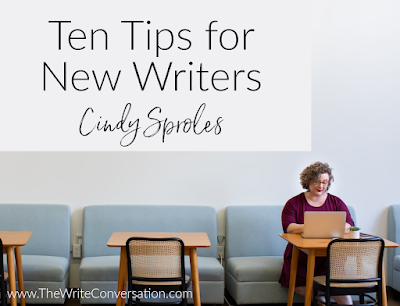
by Cindy K. Sproles @CindyDevoted
Over the years, I've learned there are hundreds of tips and ideas that can help you write good fiction and nonfiction. I've also learned that those tips change like the ebb and flow of the ocean. What rings true today changes a year later.
It can be frustrating, learning one thing and then having it switch the next time you go to a conference, but there are pros and cons to the changes. The pros are we need to continually tuck away new thought processes, style changes, and hints for our writing. A writer's toolbox should overflow with tons of new suggestions and tips. However, the con to these changes is—well—changes. Who really likes changes? Learning the popular desire of publishers today only to have it detour tomorrow grows frustrating. Stick with it.
The point is, you can never learn too much, and you should store away what you cannot use today, for tomorrow is another day just waiting for new innovative thoughts.
Here are ten stable and unwavering tips for writers to rest on with their work.
1. Read, read, read: You must read in your genre. Reading in your genre helps you learn new styles, dialogue oddities, and plot twists you may not have realized were available. Reading in your genre enables you to become more confident in writing in that genre. Read, read, read. This never changes.
2. Don't box yourself into one genre: Explore your avenues in fiction and nonfiction. You never know when you may be asked to write in a different direction. Not only that, but build your platform across the board. If you're a fiction writer, work on nonfiction articles or devotions so your name grows on the nonfiction side, and the same goes for a nonfiction writer. Learn to write short stories, flash fiction or begin a novel, so you benefit readers on the fiction end. There is nothing better than having back pocket surprises and a platform to show for them.
3. Write daily: I've heard it said the credence of writers is, "Butt in the chair and fingers on the keyboard." Though there are times you may need to rest or step to the side, the point is, writing daily helps you hone the craft. Practice makes perfect, and writing daily ups that project word count.
4. Be true to yourself: Appalachian historical was called "literary" when I first began to write, and there was no market for it. I met with Cecil Murphy at a conference, who gave me amazing advice. He said, "Literary isn't popular now. But don't you dare stop writing it. You write it, and write it and write it some more. Because it makes you a waymaker. The market will turn, and you will be ready when it does." I wrote other things, learning fiction and nonfiction, but I remained true to my heart of Appalachian historical. It ended up being me who helped relaunch an old genre. Six years later, my first novel is still in the top 15 of the publisher's back list. Stay true to yourself but learn. The tide will turn.
5. Explore the human condition: Some of the best fiction written come from authors who dig into the heart of situations and write the gritty truth about humanity. Savvy readers can see a "tied up in a bow ending" long before it hits, but writing reality in a solid Christian worldview brings truth to a new level and bores into a reader's heart and memory. FYI—Why do you think The Chosen has impacted so many? Truth on a human level.
6. No character is perfect: So don't write one. Give your characters depth. Allow them to make mistakes and pay the price. Let them find a way out through faith, but never write a character who comes across as perfect because none of us are perfect.
7. Angst, angst, angst: The more you dump on your character, the stronger your story will become because it forces you to layer your plot and besides, as sad as it is…we like to see our characters suffer and wait to see how they crawl out of the mire.
8. Develop your voice: Learn what your voice is and then practice it. Don't be ashamed of who you are. Your voice is your phrasing, your thought process, your tone within your writing, and characters. I'm a mountain girl, and when you read my fiction, you hear ever word from the mouth of a mountain girl. They ain't no changin' that.
9. Learn and understand the three-act structure: Every story must have a beginning, middle, and end. Know where they start and where they end and stick to it.
10. Learn to ping the senses: Every scene written should ping the senses. Touching the sounds, the touch, the noise, and the feel of things brings your story from flat on the page to standing straight up on the page.
Writing techniques will always ebb and flow, but when you learn these ten things, you can be sure they will remain constant. Pick them apart and practice them. Your toolbox will be filled with amazing things that will kickstart and refine your work.
TWEETABLE Ten Tips for New Writers from @CindyDevoted on @EdieMelson (Click to Tweet)
 Cindy K. Sproles is an author, speaker, and conference teacher. Having served for a number of years as a managing editor for Lighthouse Publishing of the Carolinas and Ironstream Media, Cindy now works as a mentor, coach, and freelance editor. She is the co-founder of Writing Right Author Mentoring Services with Lori Marett and she is the director of the Asheville Christian Writers Conference. Cindy is also the co-founder of Christian Devotions Ministries and WWW.CHRISTIANDEVOTIONS.US, as well as WWW.INSPIREAFIRE.COM. Her devotions are in newspapers and magazines nationwide, and her novels have become award-winning best-selling works. She is a popular speaker at conferences and a natural encourager. Cindy is a mountain girl, born and raised in the Appalachian mountains, where she and her husband still reside. She has raised four sons and now resorts to raising chickens where the pecking order is easier to manage. You can visit Cindy at WWW.CINDYSPROLES.COM or www.wramsforwriters.com.
Cindy K. Sproles is an author, speaker, and conference teacher. Having served for a number of years as a managing editor for Lighthouse Publishing of the Carolinas and Ironstream Media, Cindy now works as a mentor, coach, and freelance editor. She is the co-founder of Writing Right Author Mentoring Services with Lori Marett and she is the director of the Asheville Christian Writers Conference. Cindy is also the co-founder of Christian Devotions Ministries and WWW.CHRISTIANDEVOTIONS.US, as well as WWW.INSPIREAFIRE.COM. Her devotions are in newspapers and magazines nationwide, and her novels have become award-winning best-selling works. She is a popular speaker at conferences and a natural encourager. Cindy is a mountain girl, born and raised in the Appalachian mountains, where she and her husband still reside. She has raised four sons and now resorts to raising chickens where the pecking order is easier to manage. You can visit Cindy at WWW.CINDYSPROLES.COM or www.wramsforwriters.com.
Published on February 13, 2023 22:00
February 12, 2023
10 Steps to Take Right Now to Help You Fall Back in Love with Writing
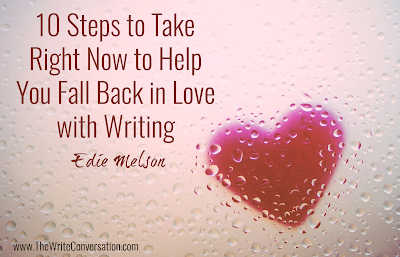
by Edie Melson @EdieMelson
Tomorrow is Valentine's Day. And I want to take this opportunity to remind us all how to stay in love with the writing life!
I’m a member of several writing groups, and I’m always amazed at the different reactions people have to similar situations. For instance, one writer might leave a critique session in tears, questioning whether or not the call to write was real. Another writer might have just as challenging a critique and leave energized because she now has the insight she needs to improve.
I’ve begun paying attention to the way the writers I respect handle this writing life. I’ve noticed that even though life gets hard at times, they never fall out of love with writing. I’m trying to take deliberate steps to guard my love of writing and not let things and/or people steal it from me. Today I’d like to share what I’ve discovered with you.
10 Ways to Fall Back in Love With Writing1. Stop Being a One Way Writer. By this I mean that we’re only happy when things turn out one way. We want things a certain way and in a certain time-frame. Truthfully, it’s the writers who are flexible that stay deeply in love with the writing life.
2. Be willing to Let Go of Expectations. This one word can derail us for months, or even years, if we let it. It’s fine to make plans, but we can’t hang our hope—or our love of writing—on expectations.
3. Start Learning to Roll with the Punches. Hard times will come in this business. Landing a book deal and/or an agent is tough, and rarely happens quickly. When we have those two things, life can still blindside us. Contracts are cancelled, editors and agents move on without us. We’ve got to pick ourselves up and get back to writing, no matter what happens.
4. Stop Looking Backward. If we dwell on the way things used to be in publishing, we’ll always be miserable. Not because things were always better, but because we think we remember them being better. Whether they were or weren’t really isn’t the point. What we need to do is learn what we can from the past and then keep our eyes firmly forward.
5. Quit Chasing Trends. It’s tempting to tailor what we’re writing to what’s currently popular with publishers. But that’s a dead end road. There’s always something new, and it’s just not possible to pull out a crystal ball and write to what’s going to be hot when it hit the market. A wise writer gave me some advice I’ve never regretted following. “Write your passion. Don’t settle. Write what you love.” Kristen Heitzmann
6. Don't Listen to the Negative Voices. There are two types of negative voices—the ones that live in your head and the ones belonging to those around us. I believe it’s the ones inside us that are the most dangerous. For one thing, they’re much more brazen. They say things that we’d never speak out loud. But if we let others also talk us out of following our dreams, they can be dangerous too. Take constructive criticism, but don’t let the negative words bring you down.
7. Refuse to Give in to Fear. No matter how much we achieve as writers, we’re still fearful. We’re afraid of failure, of ridicule, even of success. But those writers who keep their joy are the ones who continue on in spite of the fear. They even get stronger because of the fear they overcome.
8. Reject Perfectionism. We want to strive for our very best. But we need to understand that perfection is out of our grasp. Perfectionism can keep us from submitting our work for publication, and it can even keep us from writing. Aim high and always keep learning, but be willing accept the best you can do.
9. Write Regularly. I truly believe that if our purpose in life is writing, and we don't make time to write, we'll be miserable. I know so many people who want to write, know they're called to write, and yet let everything else squeeze out the time to write. They are some of the most stressed out folks you'll ever see.
10. Don't Forget the Reason You Started Writing in the First Place. We can get so caught up in the chase, that we forget why we entered the race. For me, God made me a writer. I process life through words. When I hit hard times and good times, one of my first actions is to record it, process it, and cope with it through writing. When I return to that, no matter what else is going on, everything falls into place.
These are the ways I’ve found to make sure I never fall out of love with writing. What would you add?
Don’t forget to join the conversation!Blessings,Edie
TWEETABLE10 Steps to Take Right Now to Help You Fall Back in Love with Writing from author @EdieMelson (Click to Tweet)
 Edie Melson is a woman of faith with ink-stained fingers observing life through the lens of her camera. No matter whether she’s talking to writers, entrepreneurs, or readers, her first advice is always “Find your voice, live your story.” As an author, blogger, and speaker she’s encouraged and challenged audiences across the country and around the world. Her numerous books reflect her passion to help others develop the strength of their God-given gifts and apply them to their lives. Connect with her on her website, through Facebook, Twitter and Instagram.
Edie Melson is a woman of faith with ink-stained fingers observing life through the lens of her camera. No matter whether she’s talking to writers, entrepreneurs, or readers, her first advice is always “Find your voice, live your story.” As an author, blogger, and speaker she’s encouraged and challenged audiences across the country and around the world. Her numerous books reflect her passion to help others develop the strength of their God-given gifts and apply them to their lives. Connect with her on her website, through Facebook, Twitter and Instagram.
Published on February 12, 2023 22:00
February 11, 2023
Writing to Those Who are Crushed and Hurting

by Martin Wiles @LinesFromGod
I had read many papers, but the crushing she described stood out.
Unfortunately, teachers don’t always have the opportunity to get involved in the details of their students’ lives. And I hadn’t in hers. She was a new student who had transferred in from another school. I rarely saw her talking to her peers, and I’m not sure she had said one word to me in the first nine weeks after she arrived at our school. But then, I read her story.
One assignment entailed the students writing about an event that had impacted their lives. A few wrote about sports. A few more about their grandparents dying. One penned a story about a family squabble and a resulting death. Another noted how losing a pet had impacted him. More than I imagined wrote about broken families. Another new student told why he had come to our school—bad behavior at his previous school. He was glad for another chance.
But this one student talked about her parents’ divorce. She was six when she witnessed her dad pack his suitcase and leave. At that age, she lost a dad and her best friend. Because her mom was in the military, the moves that followed took her far away from her dad, giving her few opportunities to see him during the year. Now, as a teen, she still felt the weight of the crushing.
“The LORD is close to the brokenhearted; he rescues those whose spirits are crushed” (Psalm 34:18 NLT).
David, too, felt crushing times. When one of his own sons rebelled and took the kingdom from him—chasing him out of town in the process. When a jealous king tried to kill him. And when he felt the weight of his sins against God.
Most of us writers have been crushed numerous times, which gives us fodder to share. And I just imagine that most if not all our readers have experienced a few crushings as well. They may even be crushed as they read our devotions, articles, and books. After all, the world is a cruel place. And the writing and publishing worlds are punishing places, too. If our readers are writers, they’ve probably received more rejections than they care to think about. Above all else, we’re all crushed because we live in a sinful world gone awry.
Many of our life’s crushings come from events we cannot control. The world throws us a curve ball. Nature behaves unruly. Others reject or harm us.
Regardless, God is there for us during the crushings, and he gives us writers the privilege of comforting and encouraging others through our crushings. Occasionally, God even designs a particular piece we write to be only for us—the balm for our troubled souls. Self-catharsis.
When I finished reading my young student’s story—and wiping the tears from my eyes—I emailed her back, told her how glad I was that she had shared her story, and reminded her that God will help us through our life-crushing experiences. Writing about her crushing helped me that day.
Crushings are a part of life, but God will walk us through each one if we reach out and take his hand. And as a writer, God will use you to help many through their crushings. Don’t ever forget you are writing to the crushed.
TWEETABLEWriting to Those Who are Crushed and Hurting from author Martin Wiles, @LinesFromGod, on @EdieMelson (Click to Tweet)
 Martin Wiles is the founder of Love Lines from God (WWW.LOVELINESFROMGOD.COM) and serves as Managing Editor for Christian Devotions and Directing Editor for VineWords. He has authored six books and has been published in numerous publications. His most recent book, DON'T JUST LIVE...REALLY LIVE, debuted in October of 2021. He is a freelance editor, English teacher, author, and pastor.
Martin Wiles is the founder of Love Lines from God (WWW.LOVELINESFROMGOD.COM) and serves as Managing Editor for Christian Devotions and Directing Editor for VineWords. He has authored six books and has been published in numerous publications. His most recent book, DON'T JUST LIVE...REALLY LIVE, debuted in October of 2021. He is a freelance editor, English teacher, author, and pastor.
Published on February 11, 2023 22:00
February 10, 2023
A Special Valentine for Writers

by Beth K. Vogt @BethVogt
Valentine’s Day is three days away.
I’m not going to go into all the different stories about the origins of the holiday. Suffice to say, we’ve made Valentine’s Day all about love and flowers and chocolates and romance.
But Valentine’s Day is steeped in words. Consider the question, “Will you be my Valentine?” Or all the cards, from ones for children all the way to adults, designed for the occasion.
I have friends who love Valentine’s Day. I also have friends who loath Valentine’s Day. Today, I want to give you, my writer friends, a valentine.
My valentine, doesn’t begin with, “Would you be …” and no, I didn’t try to make the words rhyme.
The words I’m sharing with you are these:
The Lord your God is with you,the Mighty Warrior who saves.He will take great delight in you;in his love he will no longer rebuke you,but will rejoice over you with singing.”
Wherever you are right now in your writing journey, God is with you. Are you feeling overwhelmed? A bit battered? God is your Mighty Warrior who will save you.God delights in you. He loves you. He does not condemn you. (Cross reference that truth with Romans 8:1). God rejoices over you with singing. How’s that for a love song?May your heart be encouraged, my friends. Happy Valentine’s Day.
TWEETABLEA Special Valentine for Writers from @BethVogt on @EdieMelson (Click to Tweet)
 Beth K. Vogt believes God’s best often waits behind the doors marked “Never.” She’s authored 14 novels and novellas, both romance and women’s fiction. Beth is a Christy Award winner, an ACFW Carol Award winner, and a RITA® finalist. Her novel Things I Never Told You, book one in her Thatcher Sisters Series by Tyndale House Publishers, won the 2109 AWSA Golden Scroll Award for Contemporary Novel of the Year. An established magazine writer and former editor of the leadership magazine for MOPS International, Beth blogs for Learn How to Write a Novel and The Write Conversation and also enjoys speaking to writers group and mentoring other writers. She lives in Colorado with her husband Rob, who has adjusted to discussing the lives of imaginary people. Connect with Beth at bethvogt.com.
Beth K. Vogt believes God’s best often waits behind the doors marked “Never.” She’s authored 14 novels and novellas, both romance and women’s fiction. Beth is a Christy Award winner, an ACFW Carol Award winner, and a RITA® finalist. Her novel Things I Never Told You, book one in her Thatcher Sisters Series by Tyndale House Publishers, won the 2109 AWSA Golden Scroll Award for Contemporary Novel of the Year. An established magazine writer and former editor of the leadership magazine for MOPS International, Beth blogs for Learn How to Write a Novel and The Write Conversation and also enjoys speaking to writers group and mentoring other writers. She lives in Colorado with her husband Rob, who has adjusted to discussing the lives of imaginary people. Connect with Beth at bethvogt.com.
Published on February 10, 2023 22:00
February 9, 2023
Social Media for Writers: Why Scheduling Facebook is Tricky & Tips for Scheduling Tweets
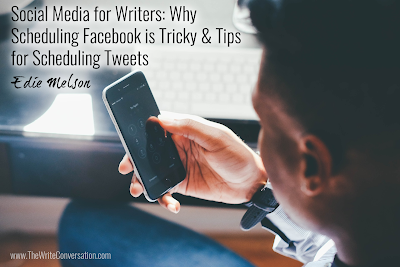
by Edie Melson @EdieMelson
Through the years I’ve taught a lot about how scheduling our social media updates can streamline the process and save hours of time for writers.
That hasn’t changed.
What HAS changed are the tools and the process I use.
Let’s begin with Facebook. No one is shocked to learn that, over the years, Facebook has changed their rules regarding scheduled updates.
There was a time when a writer could schedule Facebook updates without worries about visibility and rules.
That’s no longer the case.
Information for Writers About Scheduling Posts on Facebook
Let’s get the terminology down because it matters what we’re talking about to understand the rules and etiquette.A personal profile is where people FRIEND youA Page is where people LIKE or FOLLOW youA Group is a place to JOIN
Scheduling on Facebook Personal ProfileFacebook has decreed that there are to be NO scheduled updates on a Personal Profile. They don’t allow Buffer, Hootsuite or any other schedule platform permission to post a schedule update on your personal profile.
However, there is still a work around and it’s a VERY BAD IDEA to use. It’s still possible to have your website send automatic updates about a new blog post to Facebook.
Why is that a bad idea? Because Facebook doesn’t allow those automatic updates to be seen. They don’t show up in a newsfeed and they often don’t even show up if someone visits your personal profile. Why didn’t we know this? Because they DO show up on your personal profile if you’re the one who owns the site. So we assume others are seeing them, and that’s just not the case.
What to do about scheduling on your Facebook Personal Profile? Don’t do it.
Scheduling on a Facebook Professional PageFacebook has also decreed there isn’t to be any third-party scheduling allowed on a Professional Page. This means FB won’t give Buffer, Hootsuite or any other scheduling platform permission to schedule an update.
Again, you could use the website work around, but that leads to the same issue. It won’t be seen by almost anyone but you.
There is another option and it’s a VERY GOOD IDEA. That is to use the Meta Business Suite to schedule your posts on your page. This is Facebook’s own in-house scheduling process and it works very well to schedule the posts to your page.
NOTE: You can also you Meta Business Suite to schedule posts to Instagram.
Here’s how to schedule on your Facebook Page:Make sure you’re using your page as your page, not your personal profile. To switch, click the circle with your image in the upper RIGHT-hand corner of the pageClick SEE ALL PROFILESClick on Your pageOnce you’re using your page as your page, click on META BUSINESS SUITE in the LEFT-hand menu (It’s under MORE TOOLS)This opens a new window. Once here, click on CREATE POSTCreate your post and add any images you want.Now scroll slightly and you’ll see three options, PUBLISH NOW, SCHEDULE, SAVE AS DRAFT. Click SCHEDULE and choose the time and date.
Scheduling in a Facebook GroupFacebook has also decreed there isn’t to be any third-party scheduling allowed in a Group. This means FB won’t give Buffer, Hootsuite or any other scheduling platform permission to schedule an update.
Again, you could use the website work around, but that leads to the same issue. It won’t be seen by almost anyone but you.
There is another option and it’s a VERY GOOD IDEA. That is to use the option in your update window in your group to schedule the post.
How to Schedule in Your Facebook GroupClick in the update window. Write your update and add any images you want to include.Click the calendar icon in the bottom right of the update window and use that to schedule your post.
Information About Scheduling Posts on Twitter
For years and years, I’ve used Hootsuite as my scheduling program of choice. That’s no longer the case.
Hootsuite has done away with their free option and even their professional option—which used to be 9.99 a month and a great option—is now, in my opinion, crazy expensive.
I’ve gone back to using Tweetdeck as my scheduling program.
Tweetdeck is great! Here’s what I love about it:It’s free.It’s owned by Twitter so connecting accounts is easy.It’s got a great dashboard so I can follow hashtags and accounts. It doesn’t appear to have a time or quantity limit on scheduling. So you can schedule a long time out and you can schedule as many updates as you wish.
All you have to do to get started with Tweetdeck is go to www.tweetdeck.com. For me, it immediately connected my twitter account. But you may find you need to give it permission.
These are the steps I use to schedule my social media updates. I’d love to know what you use and any questions you might have. Be sure to leave your thoughts in the comment section below!
Don’t forget to join the conversation!Blessings,Edie
TWEETABLESocial Media for Writers: Why Scheduling Facebook is Tricky & Tips for Scheduling Tweets from @EdieMelson (Click to Tweet)
 Edie Melson is a woman of faith with ink-stained fingers observing life through the lens of her camera. No matter whether she’s talking to writers, entrepreneurs, or readers, her first advice is always “Find your voice, live your story.” As an author, blogger, and speaker she’s encouraged and challenged audiences across the country and around the world. Her numerous books reflect her passion to help others develop the strength of their God-given gifts and apply them to their lives. Connect with her on her website, through Facebook, Twitter and Instagram.
Edie Melson is a woman of faith with ink-stained fingers observing life through the lens of her camera. No matter whether she’s talking to writers, entrepreneurs, or readers, her first advice is always “Find your voice, live your story.” As an author, blogger, and speaker she’s encouraged and challenged audiences across the country and around the world. Her numerous books reflect her passion to help others develop the strength of their God-given gifts and apply them to their lives. Connect with her on her website, through Facebook, Twitter and Instagram.
Published on February 09, 2023 22:00
February 8, 2023
Using Talk-to-Text As a Writing Tool

by Julie Lavender @JLavenderWrites
Sometimes when I get stuck while working on a writing assignment, fresh air and talk-to-text are just what I need to get the creative muses stirring again. Something about being surrounded by God’s creations helps me think clearly, brainstorm new ideas, and formulate the words I want to complete my assignment.
Have you tried creating short pieces with talk-to-text?
Though I could use the note-taking app on my phone, the process that works best for me is to compose the article in an email to myself. I actually find that I don’t do as much self-editing when I’m walking and talking as I do when I’m plucking away at the keyboard. And, either way works for me – editing as I go or splashing the words onto the page and editing later. Sometimes I’m in the mood for one practice, and on other days the opposite works best.
When I’m stuck and need a change of scenery though, I usually prefer to get the words and ideas on the paper, and then edit later.
That’s why composing my article through talk-to-text works well.
I change into comfortable clothes to suit the temperature outside, lace up my walking shoes, and head out the door. Just like with any writing project, I pray over the manuscript first, then get started.
I walk and talk aloud, composing my article as I get in my steps. I instruct my smart phone to insert the punctuation marks as I go, as well as the paragraph indentions. If I change thoughts along the way, I don’t always delete. Sometimes I leave the words in to alter later. And when I’m finished, I hit “send” and launch the email to myself. When I get back home after the walk, I have my first draft ready to pull up, copy, and paste into a word document.
I make the necessary corrections, and for this southern girl, that means changing “riding” to “writing” throughout the paper, as well as fixing other dialect blunders. (You’d think if I purchased the phone in south Georgia, it would come with appropriate software to understand the words drawling from my lips.)
I edit, edit, and re-edit, and my article is complete.
You know, I like to attribute fresh air and nature with my creative success, but God also designed our bodies in His magnificent, sovereign way such that a brisk walk encourages creativity through several processes.
According to a report by the Mayo clinic, physical activity causes the brain to produce and release endorphins. These hormones help a person feel better and increase positivity – two qualities that encourage a writer’s creativity.
Walking (and other means of exercise) improves a person’s mood by lowering levels of anxiety, encouraging relaxation, and increasing self-confidence. Again – all show up as a boost to a writer’s creativity!
Physical activity reduces stress levels, too. The “feel-good” endorphin chemical can relieve the body’s stressors and help a writer forget (or at least put aside thoughts of) the stress and irritations of the day, giving the writer the mental ability to focus completely on the article or work at hand.
And yet another study pointed out that exercise stimulates neurotransmitters that quite possibly encourage the growth of brain cells in the hippocampus. This recent study suggests that cells in the hippocampus enable a person to think of new ideas and situations – just what the doctor ordered for a writer!
All that medical and scientific jargon aside … walking outside in God’s beautiful world heightens my creative muses and often helps me get un-stuck with a writing assignment. Speaking my words aloud in a talk-to-text email while walking gives me the opportunity to get additional steps in for my day, benefit my health, and complete my writing task.
Have you used the talk-to-text function to compose a blog post or article? How did it work out for you? Share your thoughts below and join the conversation.
TWEETABLEUsing Talk-to-Text As a Writing Tool from author @JLavenderWrites on @EdieMelson (Click to Tweet)
 Though Julie’s admitted lack of gracefulness limits her ability to walk and chew gum at the same time, she’s enjoyed multi-tasking opportunities of walking and composing articles, by way of talk-to-text, on a number of occasions. She’s the author of Children’s Bible Stories for Bedtime, published by a Penguin Random House Imprint, and 365 Ways to Love You Child: Turning Little Moments into Lasting Memories, published by Revell. She’s also written more than 1000 newspaper and magazine articles and enjoys encouraging fellow writers to get their foot in the door of the publishing industry with shorter pieces. Connect with Julie at julielavenderwrites.com and on social media platforms.
Though Julie’s admitted lack of gracefulness limits her ability to walk and chew gum at the same time, she’s enjoyed multi-tasking opportunities of walking and composing articles, by way of talk-to-text, on a number of occasions. She’s the author of Children’s Bible Stories for Bedtime, published by a Penguin Random House Imprint, and 365 Ways to Love You Child: Turning Little Moments into Lasting Memories, published by Revell. She’s also written more than 1000 newspaper and magazine articles and enjoys encouraging fellow writers to get their foot in the door of the publishing industry with shorter pieces. Connect with Julie at julielavenderwrites.com and on social media platforms.
Published on February 08, 2023 22:00



